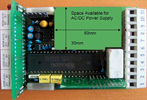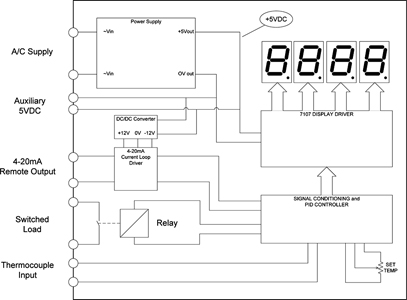

Recom International Power has been in the DC/DC converter business for over 30 years, but only recently has it expanded into the AC/DC market. In the beginning, its primary motivation was to be able to offer a complete product portfolio, a ′one-stop-shop′, for all its customer′s power conversion needs. However, now, after a year′s experience, is it beginning to appreciate the advantages and market niches that AC/DC converters exploit.
As with most electronic components, the cost/performance ratio is the most critical. An AC/DC module costs many times the equivalent of a mains transformer, diode bridge, smoothing capacitor and linear regulator and even costs more than a discrete AC/DC switching regulator made up from individual components, so where is the performance advantage? This is perhaps best explained with a concrete example.
Let us take a typical industrial application: a mains-powered PID temperature controller. The specification might be: universal input voltage (110/230 V a.c.), relay output, LED display, remote monitoring output, standard DIN panel mounting case and it should meet the usual safety and EMI standards. A quick guesstimate for the power supply loads gives 1 W for the display, 1 W for the signal-conditioning electronics and relay, and 1 W for the 4-20 mA current loop driver. We want to keep costs down and reliability high, so we will use a standard 7107 LED display driver and analog circuitry, rather than a microcontroller.
So far, so good! But now we have to fit all of this into a 72 x 36 DIN standard case. After laying out the board, we find that we have about 50 x 30 mm real estate free on the board and around 20 mm of height available for the AC power supply. A standard flat-style mains transformer with 3,2 VA rating already fills most of this space up and we still have not yet considered the space requirements for the rectification, regulation, input voltage range switch or input filter components. Furthermore, the transformer is the heaviest component in the design and will need additional screw fixings to avoid excessive stress to the circuit board. We could design our own discrete converter if we were familiar with switch-mode power supplies, but would you like to be on the production line doing the calibration and final QA check with exposed live components and voltages exceeding 325 V d.c. on the board?

Advantages of a module
This is where the advantages of an AC/DC module suddenly become obvious. The Recom RAC05-05SB, for example, is a 2" x 1" (50,8 x 25,4 mm) converter only 15 mm in height, yet it packs a fully-regulated 5 W converter with universal input voltage (90-265 V a.c.) into this tiny space and weighs only 30 grams. The module is completely potted and sealed, so no dangerous internal voltages are present to shock the careless or unwary. The 3 kV a.c. isolation and built-in filters mean that the module will meet CE, TÜV, EN60950 safety and EN55022 EMC standards with no external components and the short-circuit protection feature means that it is safe to allow the 5 V d.c. supply to be led out as an auxiliary supply to the connectors at the back.
The auxiliary power supply connection has a double function. With the AC/DC converter powered down, an external 5 V supply can be connected to these terminals without damaging the converter. This means that all of the function tests and adjustments can be made to the temperature controller on the production line, using a safe low voltage DC power supply.
There will always be applications where the low cost of a standard linear AC/DC power supply are more important than its bulky size and heavy transformer, and there will always be large volume commercial applications where the costs savings of a discrete AC/DC converter solution outweigh the disadvantages of hazardous voltages on the PCB and the extra costs for certification. But for every other application, the compact size, safety and ease of use, will make the AC/DC module the preferred solution.
| Tel: | +27 21 706 3162 |
| Email: | [email protected] |
| www: | www.brabek.co.za |
| Articles: | More information and articles about Brabek |

© Technews Publishing (Pty) Ltd | All Rights Reserved